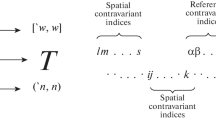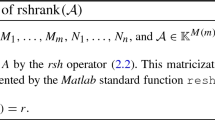Abstract
The paper deals with an algebraic algorithm for the pseudotensors weights eliminating and recovering. The proposed algorithm allows us to reduce pseudotensors of arbitrary ranks and weights to absolute tensors of higher ranks. The weight of a pseudotensor is assumed to be an integer (positive or negative). The algorithm is based on the transformation of a pseudotensor of arbitrary rank and integer weight by using tensor product of permutation symbols. The requisite equations from algebra and analysis of pseudotensors are given and discussed. Based on the proposed algebraic algorithm, covariant constancy of permutation symbols and fundamental orienting pseudoscalar powers, a realisation of covariant differentiation of a pseudotensor field of arbitrary rank and integer weight is developed. The definition of the pseudotensor field gradient is then introduced.

Similar content being viewed by others
Notes
As some authors pointed out [3, p. 159], weights of rational pseudoinvariants can be sometimes fractional.
In micropolar elasticity microrotation vector can be represented by the covariant pseudovector \({{\mathop \phi \limits^{[ - 1]} }_{{s}}}\), absolute vectors \({{\phi }^{s}}\) (or \({{\phi }_{s}}\)), and contravariant pseudovector \({{\mathop \phi \limits^{[ + 1]} }^{{s}}}\). Pseudovector components are known insensitive to the mirror reflections of local coordinate frame.
Note that this realisation can be used not only in Euclidean spaces, but also in Riemannian ones [2].
The equation (15) also makes sense for fractional weights, but with one limitation: in left-handed coordinate systems powers ew must be real.
The Hamilton nabla operator is defined according to: \(\nabla = \mathop {\boldsymbol\imath} \limits^k {\kern 1pt} {{\partial }_{k}}\).
REFERENCES
B. A. Rozenfeld, Multidimensional Spaces (Nauka, Moscow, 1966) [in Russian].
L. P. Eisenhart, Riemannian Geometry (Princeton Univ. Press, Princeton, 1997).
G. B. Gurevich, Foundations of the Theory of Algebraic Invariants (Noordhoff, Groningen, 1964).
J. L. Synge and A. Schild, Tensor Calculus (Dover, New York, 1978).
J. A. Schouten, Tensor Analysis for Physicist (Clarendon Press, Oxford, 1951).
J. F. Rudge, “A micropolar continuum model of diffusion creep,” Phil. Mag. 101 (17), 1913–1941 (2021). https://doi.org/10.1080/14786435.2021.1946191
H. Abedi, S. Capozziello, M. Capriolo, and A. M. Abbassi, “Gravitational energy–momentum pseudo-tensor in Palatini and metric f(R) gravity,” Annals Phys. 439, 168796 (2022). https://doi.org/10.1016/j.aop.2022.168796
S. J. Crothers, “The Einstein and Landau-Lifshitz pseudotensors — A mathematical note on existence,” Phys. Essays 33 (3), 268–270 (2020). https://doi.org/10.4006/0836-1398-33.3.268
Y. Koutsawa, “New micromechanics approaches for the effective properties of multiferroics composites with spring-type imperfect interfaces,” Compos. Struct. 211, 41–55 (2019). https://doi.org/10.1016/j.compstruct.2018.12.025
Yu. N. Radaev and E. V. Murashkin, “Pseudotensor formulation of the mechanics of hemitropic micropolar media,” Probl. Prochn. Plastichn. 82 (4) 399–412 (2020). https://doi.org/10.32326/1814-9146-2020-82-4-399-412
S. A. Balbus, “A Poynting theorem formulation for the gravitational wave stress pseudo tensor,” Int. J. Modern Phys. D 30 (14), 2142003 (2021). https://doi.org/10.1142/S0218271821420037
E. V. Murashkin and Yu. N. Radayev, “On a micropolar theory of growing solids,” Vestn. Samar. Gos. Tekhn. Univ., Ser. Fiz.-Mat. Nauki 24 (3), 424–444 (2020). https://doi.org/10.14498/vsgtu1792
V. A. Kovalev, E. V. Murashkin, and Yu. N. Radayev, “On the Neuber theory of micropolar elasticity. A pseudotensor formulation,” Vestn. Samar. Gos. Tekhn. Univ., Ser. Fiz.-Mat. Nauki 24 (4), 752–761 (2020). https://doi.org/10.14498/vsgtu1799
Yu. N. Radayev, E. V. Murashkin, and T. K. Nesterov, “On covariant non-constancy of distortion and inversed distortion tensors,” Vestn. Samar. Gos. Tekhn. Univ., Ser. Fiz.-Mat. Nauki 26 (1), 36–47 (2022). https://doi.org/10.14498/vsgtu1891
Yu. N. Radayev, E. V. Murashkin, and T. K. Nesterov, “Pseudotensor formalism for neuber’s micropolar elasticity theory,” Vestn. Chuvash. Gos. Ped. Univ. Im. I. Ya. Yakovleva Ser.: Mekh. Pred. Sost., No. 4(50), 73–81 (2021). https://doi.org/10.37972/chgpu.2021.50.4.006
E. V. Murashkin and Yu. N. Radayev, “On a pseudotensor generalization of the Hugoniot-Hadamard linking boundary conditions,” Vestn. Chuvash. Gos. Ped. Univ. Im. I. Ya. Yakovleva Ser.: Mekh. Pred. Sost., No. 2(48), 104–114 (2021). https://doi.org/10.37972/chgpu.2021.48.2.013
E. V. Murashkin and Yu. N. Radayev, “Pseudovector hyperbolic differential operators of hemitropic micropolar elasticity,” Vestn. Chuvash. Gos. Ped. Univ. Im. I. Ya. Yakovleva Ser.: Mekh. Pred. Sost., No. 4(50), 59–72 (2021). https://doi.org/10.37972/chgpu.2021.50.4.005
O. Veblen and T. Y. Thomas, “Extensions of relative tensors,” Trans. Am. Math. Soc. 26 (3), 373–377 (1924). https://www.jstor.org/stable/1989146
O. Veblen, Invariants of Quadratic Differential Forms (Cambridge Univ. Press, Cambridge, 1927).
C. Truesdell and R. Toupin, “The classical field theories,” in Principles of Classical Mechanics and Field Theory, Ed. by S. Flügge (Springer, Berlin, Heidelberg, 1960), pp. 226–858. https://doi.org/10.1007/978-3-642-45943-6_2
A. J. Mc Connell, Application of Tensor Analisys (Dover, New York, 1957).
I. S. Sokolnikoff, Tensor Analysis: Theory and Applications to Geometry and Mechanics of Continua (John Wiley & Sons Inc., New York, 1964).
Funding
This study was in part financially supported by the Ministry of Science and Higher Education of the Russian Federation (State Registration Number AAAA-A20-120011690132-4) and by the Russian Foundation for Basic Research project no. 20-01-00666.
Author information
Authors and Affiliations
Corresponding authors
Additional information
Translated by M. Katuev
About this article
Cite this article
Murashkin, E.V., Radayev, Y.N. An Algebraic Algorithm of Pseudotensors Weights Eliminating and Recovering. Mech. Solids 57, 1416–1423 (2022). https://doi.org/10.3103/S0025654422060085
Received:
Revised:
Accepted:
Published:
Issue Date:
DOI: https://doi.org/10.3103/S0025654422060085




